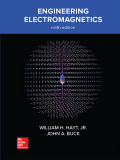
Engineering Electromagnetics
9th Edition
ISBN: 9781260029963
Author: Hayt
Publisher: MCG
expand_more
expand_more
format_list_bulleted
Concept explainers
Question
Chapter 4, Problem 4.32P
To determine
(a)
The energy stored in dipole field in the region
To determine
(b)
The reason for not letting an approach to be zero as a limit.
Expert Solution & Answer
Want to see the full answer?
Check out a sample textbook solution
Students have asked these similar questions
Don't use ai to answer I will report you answer
Don't use ai to answer I will report you answer
NO AI PLEASE will reject.
Chapter 4 Solutions
Engineering Electromagnetics
Ch. 4 - Given E = Exax + Eyay + Ez3z V/m, where EX, Ey,...Ch. 4 - A positive point charge of magnitude q1 lies at...Ch. 4 - Given E=Epap+Ea+Ez+azV/m, where Ep, E and E2 are...Ch. 4 - An electric field in free space is given by...Ch. 4 - Consider the vector field G = (A/p) aa where A is...Ch. 4 - A electric field in free space is given as...Ch. 4 - Prob. 4.7PCh. 4 - Given E=-xax+yay,(a) find the work involved in...Ch. 4 - An electric field intensity in spherical...Ch. 4 - A sphere of radios a carries a surface density of...
Ch. 4 - At large distances from a dipole antenna (to be...Ch. 4 - Prob. 4.12PCh. 4 - Thee identical point charges of 4 pC each are...Ch. 4 - Given the electric field E=(y+1)ax+(x1)ay+2az find...Ch. 4 - Two uniform lines, 8 nC/m, are located at x=1, z=2...Ch. 4 - A spherically symmetric charge distribution in...Ch. 4 - Uniform surface charge densities of 6 and 2 nC/m2...Ch. 4 - Find the potential at the origin produced by a...Ch. 4 - Volume charge density is given as pv=poer/C/m3,...Ch. 4 - En a certain medium, the electric potential is...Ch. 4 - Prob. 4.21PCh. 4 - A Line charge of infinite length lies along the z...Ch. 4 - Prob. 4.23PCh. 4 - A certain spherically symmetric charge...Ch. 4 - Consider an electric field intensity in free space...Ch. 4 - Let us assume that we have a very thin, square,...Ch. 4 - By performing an appropriate Line integral from...Ch. 4 - Prob. 4.28PCh. 4 - A dipole having a moment P=3ax-5ay+10aznC.m is...Ch. 4 - Prob. 4.30PCh. 4 - A potential field in free space is expressed as...Ch. 4 - Prob. 4.32PCh. 4 - Prob. 4.33PCh. 4 - A sphere of radius a contains volume charge of...Ch. 4 - Four 0.8 nC point charge are located in free space...Ch. 4 - Surface charge of uniform density ps lies on a...
Knowledge Booster
Learn more about
Need a deep-dive on the concept behind this application? Look no further. Learn more about this topic, electrical-engineering and related others by exploring similar questions and additional content below.Similar questions
- Don't use ai to answer I will report you answerarrow_forwardHow can I design a socket for a trolley headlight? What parameters should I measure? The only thing I have is the headlight itself, and I don’t have any information about its power, current, or voltage rating. The power source is 120 V, and my goal is simply to get the headlight to turn on.I’m not sure where to start or what to measure. Any recommendations would be greatly appreciated!arrow_forwardFigure 2 3) *** The circuit of Figure 3 is designed with W/L = 20/0.18, λ= 0, and ID = 0.25 mA. (Optional- 20 points) a) Compute the required gate bias voltage. b) With such a gate voltage, how much can W/L be increased while M1 remains in saturation? What is the maximum voltage gain that can be achieved as W/L increases? VDD = 1.8 V RD 2k - Vout Vin M₁ Figure 3arrow_forward
- 1) Rs = 4kQ, R₁ = 850 kQ, R₂ = 350 kQ, and R₁ = 4 kQ. The transistor parameters are VTP = -12 V, K'p = 40 µA / V², W/L = 80, and λ = 0.05 V-1. (50 Points) a) Determine IDQ and VSDQ. b) Find the small signal voltage gain. (Av) c) Determine the small signal circuit transconductance gain. (Ag = io/vi) d) Find the small signal output resistance. VDD = 10 V 2'; www www Figure 1 Ссarrow_forwardQ11arrow_forwardQ15arrow_forward
arrow_back_ios
SEE MORE QUESTIONS
arrow_forward_ios
Recommended textbooks for you
 Introductory Circuit Analysis (13th Edition)Electrical EngineeringISBN:9780133923605Author:Robert L. BoylestadPublisher:PEARSON
Introductory Circuit Analysis (13th Edition)Electrical EngineeringISBN:9780133923605Author:Robert L. BoylestadPublisher:PEARSON Delmar's Standard Textbook Of ElectricityElectrical EngineeringISBN:9781337900348Author:Stephen L. HermanPublisher:Cengage Learning
Delmar's Standard Textbook Of ElectricityElectrical EngineeringISBN:9781337900348Author:Stephen L. HermanPublisher:Cengage Learning Programmable Logic ControllersElectrical EngineeringISBN:9780073373843Author:Frank D. PetruzellaPublisher:McGraw-Hill Education
Programmable Logic ControllersElectrical EngineeringISBN:9780073373843Author:Frank D. PetruzellaPublisher:McGraw-Hill Education Fundamentals of Electric CircuitsElectrical EngineeringISBN:9780078028229Author:Charles K Alexander, Matthew SadikuPublisher:McGraw-Hill Education
Fundamentals of Electric CircuitsElectrical EngineeringISBN:9780078028229Author:Charles K Alexander, Matthew SadikuPublisher:McGraw-Hill Education Electric Circuits. (11th Edition)Electrical EngineeringISBN:9780134746968Author:James W. Nilsson, Susan RiedelPublisher:PEARSON
Electric Circuits. (11th Edition)Electrical EngineeringISBN:9780134746968Author:James W. Nilsson, Susan RiedelPublisher:PEARSON Engineering ElectromagneticsElectrical EngineeringISBN:9780078028151Author:Hayt, William H. (william Hart), Jr, BUCK, John A.Publisher:Mcgraw-hill Education,
Engineering ElectromagneticsElectrical EngineeringISBN:9780078028151Author:Hayt, William H. (william Hart), Jr, BUCK, John A.Publisher:Mcgraw-hill Education,

Introductory Circuit Analysis (13th Edition)
Electrical Engineering
ISBN:9780133923605
Author:Robert L. Boylestad
Publisher:PEARSON

Delmar's Standard Textbook Of Electricity
Electrical Engineering
ISBN:9781337900348
Author:Stephen L. Herman
Publisher:Cengage Learning

Programmable Logic Controllers
Electrical Engineering
ISBN:9780073373843
Author:Frank D. Petruzella
Publisher:McGraw-Hill Education

Fundamentals of Electric Circuits
Electrical Engineering
ISBN:9780078028229
Author:Charles K Alexander, Matthew Sadiku
Publisher:McGraw-Hill Education

Electric Circuits. (11th Edition)
Electrical Engineering
ISBN:9780134746968
Author:James W. Nilsson, Susan Riedel
Publisher:PEARSON

Engineering Electromagnetics
Electrical Engineering
ISBN:9780078028151
Author:Hayt, William H. (william Hart), Jr, BUCK, John A.
Publisher:Mcgraw-hill Education,
8.02x - Lect 21 - Magnetic Materials, Dia- Para- & Ferromagnetism; Author: Lectures by Walter Lewin. They will make you ♥ Physics.;https://www.youtube.com/watch?v=1xFRtdN5IJA;License: Standard Youtube License